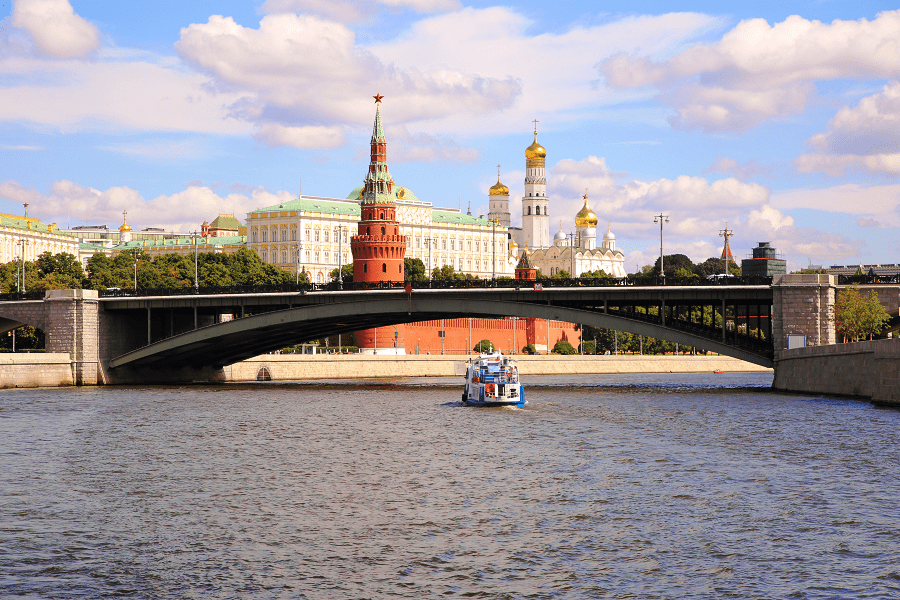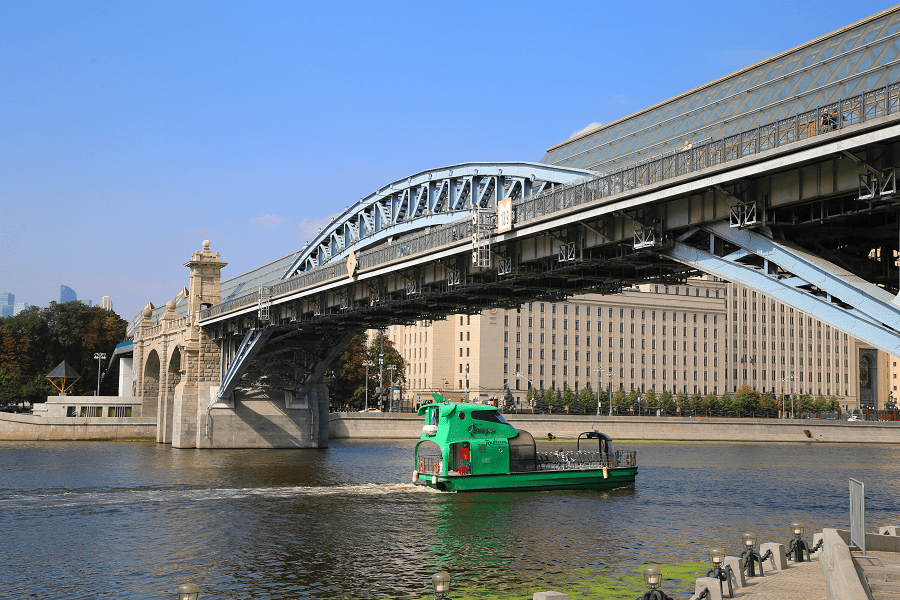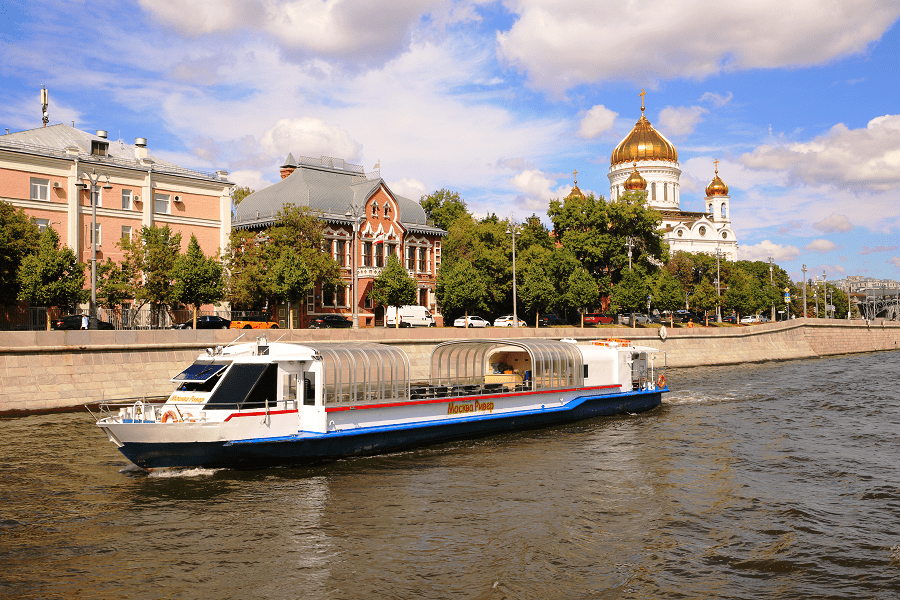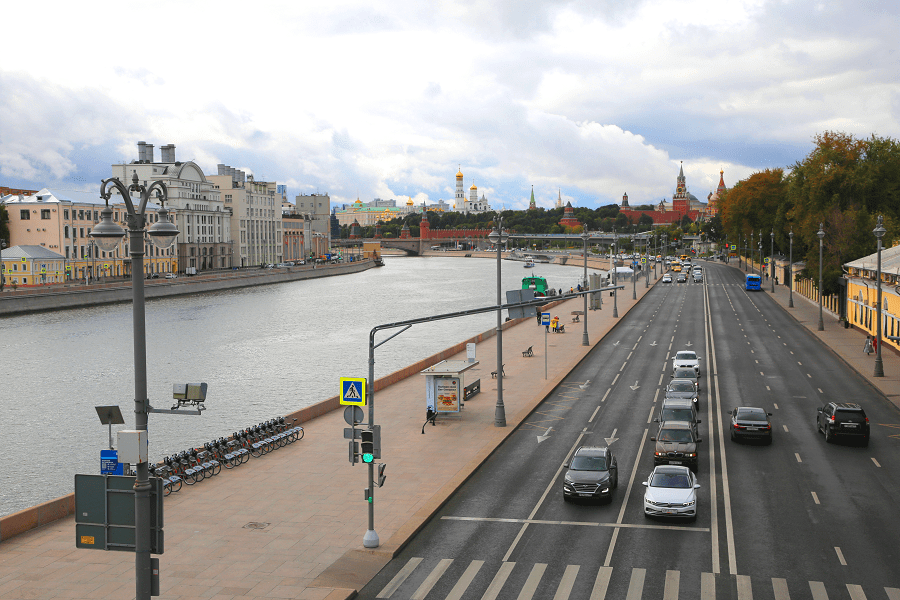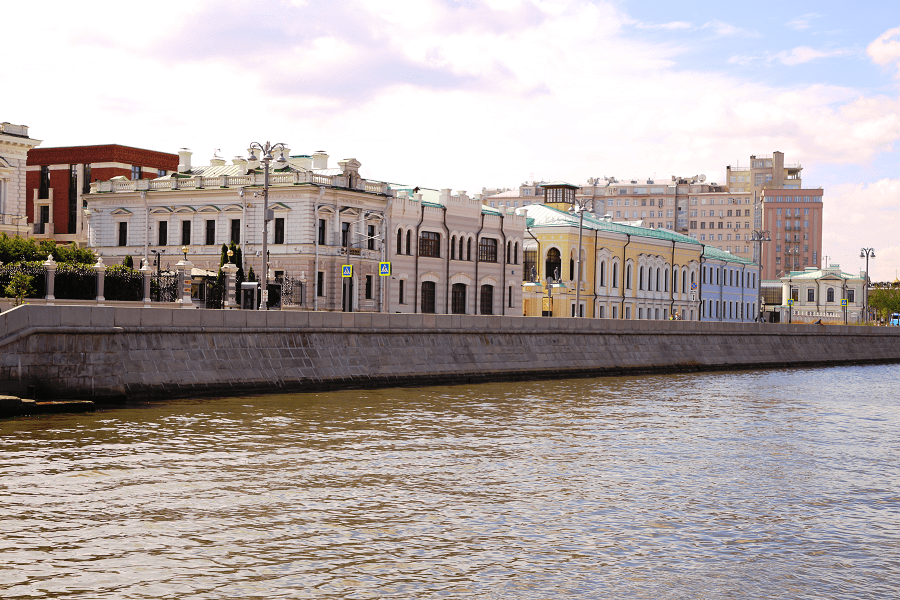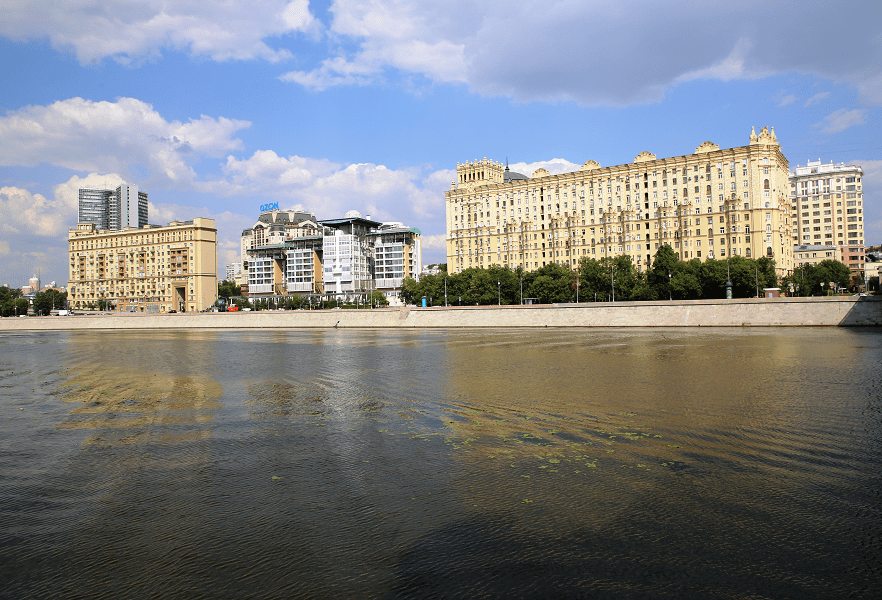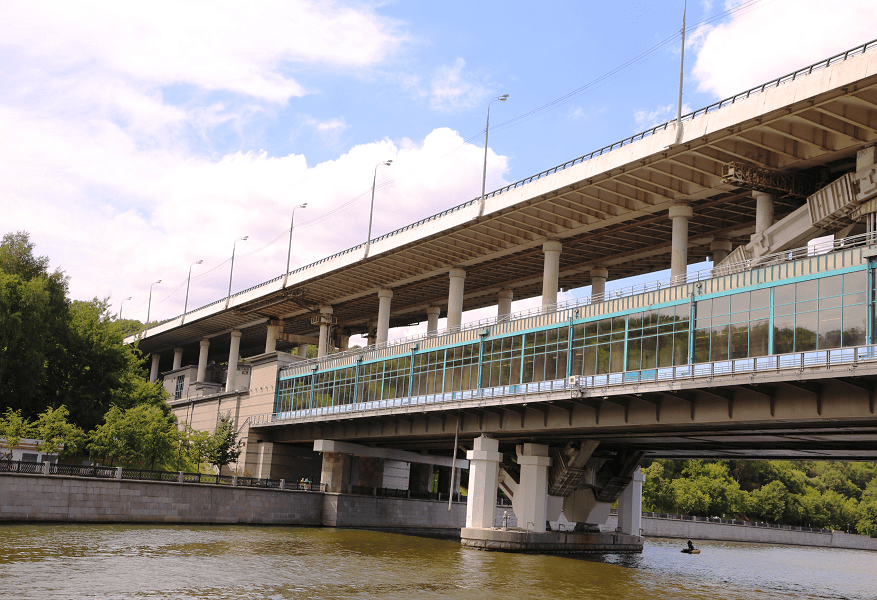Main rivers, embankments and bridges of Moscow (50 objects in alphabetical order)
Rivers
Moskva river – is a middle river in Central Russia, in the Moscow region, Moscow and, for a short distance, in the Smolensk region, the left tributary of the Oka (Volga basin). The length within the Moscow region is 473 km, traditionally also mentioned is 502 km, the basin area is 17,600 km². The river begins on the slope of the Smolensk-Moscow Upland and flows into the Oka on the territory of Kolomna. The total drop from source to mouth is 155.5 m. The largest tributaries are Ruza (left), Pakhra (right) and Istra (left). The waters of the river are widely used for water supply of the city of Moscow.
Yauza river is a small river in the Moscow region and Moscow, the left, is the largest tributary of the Moscow River within the capital. Even in the chronicles, the Yauza River is mentioned as the most critical transport artery of Ancient Rus’. It was part of the river route from the Moskva River to the Klyazma, connecting Moscow and Vladimir. Length – 48 km. The mouth of the Yauza is in the center of Moscow, near the Bolshoy Ustyinsky Bridge.
Vodootvodny Canal(drainage canal) was laid in 1783-1786 along the central bend of the Moskva River near the Kremlin. Together with the Moscow River, it forms Balchug Island.
The length of the canal is 4 km, the width is from 30 to 50 m, and the depth is about 2 m. There are 11 bridges across the canal, including five pedestrian ones. The canal bed was laid along a swampy lowland, the oxbow lake of the Moskva River on the site of the former swamp. During the laying of the canal, the swamp was drained.
Central embankments
Berezhkovskaya embankment is an embankment on the right bank of the Moskva River in the Dorogomilovo district of the Western Administrative District of Moscow. It is located between the Berezhkovsky Bridge and the Borodinsky bridge. Europe Square and Potylikh Street overlook the embankment. The numbering of houses starts from Europe Square.
Bersenevskaya embankment is an embankment of the Moskva River in the Yakimanka district of the Central Administrative District of Moscow. Passes from the arrow of the island to the Bolshoy Kamenny Bridge. Ends with Serafimovich street.
Bolotnaya Embankment (until 1922, it included the former Kokorevsky Boulevard) is an embankment along the left (northern) bank of the Vodootvodny Canal in the Yakimanka district of Moscow. It starts from the western arrow of the island between the Vodootvodny Canal and the Moscow River and ends at the Maly Moskvoretsky Bridge.
Frunzenskaya embankment is an embankment on the left bank of the Moskva River in the Khamovniki district of the Central Administrative District of Moscow. It is located between the Krymsky and Andreevsky bridges. Timur Frunze Street, 1st, 2nd and 3rd Frunzensky Streets overlook the embankment. The numbering of houses starts from the Krymsky bridge.
Gateway embankment (Schluzovaya Naberezhnaya) is an embankment on the right shores of the drainage canal and Moscow River in Zamoskvorechye of the Central Administrative District of the city of Moscow. It passes from Zacepsky Val to the Novospassky Bridge.
Goncharnaya Embankment is an embankment in the center of Moscow on the left bank of the Moskva River in the Tagansky District between 2nd Goncharny Lane and Narodnaya Street. Located between the Kotelnicheskaya and Krasnokholmskaya Embankments.
Kadashevskaya Embankment – the Vodootvodny Canal embankment in the center of Moscow in the Yakimanka and Zamoskvorechye districts between Bolshaya Polyanka and Pyatnitskaya streets. It arose on the site of the palace Kadashevskaya Khamovnaya settlement of the 17th century.
Kosmodamianskaya embankment (in 1922-1936 – Prichalnaya, Komissariatskaya, Pupyshevskaya and Krasnokholmskaya embankments, in 1936-1993 – Maxim Gorky embankment) is an embankment of the Moskva River in the Zamoskvorechye district of the Central Administrative District of Moscow. Lies between Bolshoi Ustyinsky and Shlyuzovoy Bridge. The numbering of houses is carried out from the Raushskaya embankment.
Kotelnicheskaya embankment is an embankment in Moscow on the left bank of the Moskva River, from the mouth of the Yauza and the Small Ustyinsky Bridge to the 1st Goncharny lane (between Podgorskaya embankment and Goncharnaya embankment).
Krasnokholmskaya Embankment is an embankment in the center of Moscow on the left bank of the Moskva River in the Tagansky District between Narodnaya Street and Sarinsky Proyezd. It is a continuation of the Goncharnaya embankment. It received its modern name due to its proximity to the ancient tract Red Hill. In the 19th century and until 1929, it was called Novospassky – after the Novospassky Monastery.
Krasnopresnenskaya embankment is an embankment on the left bank of the Moskva River in the Presnensky district of the Central Administrative District of Moscow. It passes under the Bagration and Novoarbatsky bridges. It is a continuation of the 4th Krasnogvardeisky lane, passes into the Smolenskaya embankment and to Presnenskaya embankment.
Kremlin embankment – the central embankment in Moscow of the Moskva River near the walls of the Kremlin. It is located between Lenivka street and Vasilyevsky descent of the Red Square. The first stone embankment in Moscow.
Krymskaya embankment is a pedestrian embankment in Moscow, located in the Yakimanka district, stretching along the right bank of the Moskva River. The embankment is bounded by Krymsky Val and 3rd Golutvinsky lane, continues Pushkinskaya embankment and turns into Yakimanskaya embankment.
Luzhnetskaya embankment is an embankment across Moskva river in the southwest of the Khamovniki district of the Central Administrative District of Moscow. It runs along the bend of the Moskva River from Frunzenskaya Embankment and Andreevsky Railway Bridge to Novodevichy Embankment and the bridges of Berezhkovsky Automobile and Luzhnetsky (New Krasnoluzhsky) Railway.
Moskvoretskaya Embankment is located in Moscow on the left bank of the Moskva River in Kitay-Gorod between Bolshoy Moskvoretsky and Bolshoy Ustinsky bridges. Moskvoretskaya embankment continues the Kremlin embankment, starting from Vasilyevsky Spusk, Moskvoretskaya Street and the Bolshoy Moskvoretsky Bridge, runs east along Zaryadye Park, Kitaigorodsky Proezd adjoins it on the left.
Prechistenskaya embankment is located on the left bank of the Moskva River in Khamovniki between Novokrymsky passage and Lenivka (Moscow, Russia). The name of the embankment appeared in the 18th century along Prechistenka Street and originally referred to only a part of its modern length. I
Presnenskaya embankment is located in Moscow on the left bank of the Moskva River in the Presnensky district between Krasnopresnenskaya embankment and Testovskaya street. Passes along the Moscow International Business Center (MIBC Moscow City).
Pushkinskaya embankment is a pedestrian embankment on the right bank of the Moskva River in the Yakimanka district of the Central Administrative District of Moscow. Pushkinskaya Embankment begins as a continuation of Krymskaya Embankment from Krymsky Val Street (Garden Ring) and Krymsky Bridge, which connects the latter with Zubovsky Boulevard.
Raushskaya embankment (Roushskaya, until the 1870s Zayaitskaya embankment) is an embankment of the Moscow River in the Zamoskvorechye district of the Central Administrative District of Moscow. It lies between Balchug Street and Bolshoy Ustynsky Bridge. The numbering of houses is from Balchug hotel. Connected with Sadovnicheskaya street 1st and 2nd Raushsky lanes.
Rostovskaya embankment is a Moscow embankment in the Khamovniki district on the left bank of the Moskva River, located between Smolenskaya embankment and Savvinskaya embankment, opposite the Kievsky railway station and Europe Square.
Sadovnicheskaya embankment is along the left (northern) bank of the Vodootvodny Canal in the Zamoskvorechye district of the Central Administrative District of Moscow. It lies between the Cast Iron Bridge (Balchug Street) and the Maly Krasnokholmsky Bridge (Garden Ring).
Savvinskaya Embankment is located on the left bank of the Moskva River in Khamovniki between Rostovskaya Embankment and Novodevichy Proyezd.
Smolenskaya embankment is located on the left bank of the Moskva River in the Arbat area between Smolenskaya street and Svobodnaya Rossii square (Moscow, Russia). The British embassy is located here. The project for the Smolenskaya embankment was developed in 1955 by architects Boris Barkhin, Vladimir Lerman and Nikolai Gaygarov.
Sofiyskaya Embankment (in 1964-1992 – Maurice Thorez Embankment) is an embankment of the Moskva River in the Yakimanka district of the Central Administrative District of Moscow. It runs from Serafimovicha Street to Balchug Street, the numbering of houses is from Serafimovicha Street. Faleevsky Lane adjoins the embankment.
Yakimanskaya embankment is a 500-meter-long embankment on the banks of the Vodootvodny Canal in Moscow. It is located between Krymskaya and Kadashevskaya embankments in the Yakimanka district of Moscow. The name of the embankment comes from Bolshaya Yakimanka Street, which in turn bears the name of the chapel of Joachim and Anna of the Church of the Annunciation in Golutvinskaya Sloboda.
Main bridges
Andreevsky Railway Bridge – the bridge of the Small Ring of the Moscow Railway across the Moskva River in Moscow, within the boundaries of the Kanatchikovo station. The modern bridge was built in 1999-2000 near the place where the old Andreevsky (Sergievsky) railway bridge built in 1905-1907 located.
Bagration Bridge is a commercial and pedestrian bridge across the Moskva River in Moscow, opened in 1997 and becoming the first building of the MIBC Moscow City. The bridge connects Krasnopresnenskaya embankment, Vystavochnaya metro station and Moscow City with Taras Shevchenko embankment and Tower 2000.
Berezhkovsky Bridge – a bridge in Moscow built across the Moskva River, opened on October 28, 1998 on the Third Transport Circle highway parallel to the Luzhnetsky railway bridge. The length of the bridge is 364 meters (4 lanes). Named after Berezhkovskaya embankment.
Bolshoy Kamenny Bridge is one of the central bridges in Moscow across the Moscow River. It connects Borovitskaya Square, Mokhovaya and Znamenka Streets near the Borovitskaya Tower of the Kremlin with Bolshaya Polyanka Street on Bolotny Island, which crosses the Vodootvodny Canal along the Maly Kamenny Bridge.
Bogdan Khmelnitsky Bridge (Kyiv Pedestrian Bridge) is a pedestrian bridge across the Moskva River that connects Berezhkovskaya and Rostovskaya embankments near the Kyiv railway station (Moscow, Russia). Named after the Ukrainian hetman. It was opened on September 1, 2001, 2.5 km upstream of the Berezhkovsky and Luzhnetsky Bridges and 200 m downstream of the Borodinsky bridge.
Bolshoy Krasnokholmsky Bridge in Moscow is a single-span steel arch bridge across the Moscow River. It is located on the Garden Ring highway between Taganskaya Square and Nizhnyaya Krasnokholmskaya Street.
Bolshoy Moskvoretsky Bridge is one of the bridges in Moscow across the Moskva River. It connects Vasilyevsky Descent, Varvarka Street with Bolshaya Ordynka Street. The extension of the bridge is the Maly Moskvoretsky Bridge across the Vodootvodny Canal.
Bolshoy Ustinsky Bridge is a bridge in Moscow at the intersection of the Moscow River with the Boulevard Ring, at the confluence of the Yauza River. It connects Yauzsky Boulevard with Sadovnichesky Proyezd, which crosses the Vodootvodny Canal along the Kommissariatsky Bridge.
Borodinsky Bridge is a three-span steel beam bridge across the Moskva River, connecting Smolenskaya Street with Bolshaya Dorogomilovskaya Street and Kievsky Railway Station (two kilometers west of the Kremlin in Moscow).
Dorogomilovsky highway and railway bridge (MIBC Moscow City Bridge) is a two-tier girder bridge in Moscow across the Moskva River on the route of the Moscow Central Circle, connecting the Dorogomilovo and Presnensky districts (Moscow). Built in 1998-1999 on the site of the old Smolensky railway bridge, next to the preserved Dorogomilovsky railway bridge of the Small Ring of Moscow Railways.
Krymsky Bridge in Moscow is a suspension bridge across the Moskva River, located on the Garden Ring highway, connecting Zubovsky Boulevard with Krymsky Val Street. Built in 1938 as part of the Master Plan for the Reconstruction of Moscow in 1935, designed by architect Alexander Vlasov and engineer Boris Konstantinov.
Luzhkov Bridge (officially called the Tretyakov Bridge) is one of the pedestrian bridges across the Vodootvodny Canal in Moscow. It connects Bolotnaya Square with Kadashevskaya Embankment. From the side of Bolotnaya Square, the bridge goes to the monument to I. E. Repin, from the opposite side – to Lavrushinsky Lane (Tretyakov Gallery).
Luzhnetsky (Luzhnikovsky) metro and vehicle bridge, also Luzhniki Bridge in Moscow – a two-tier arched bridge made of prestressed reinforced concrete across the Moscow River, connecting Luzhniki stadium and Vorobyovy Gory. The upper tier is automobile, connects Komsomolsky and Vernadsky prospects, the lower one is the Sokolnicheskaya line station of the Moscow metro “Vorobyovy Gory”.
Maly Kamenny Bridge is the second of the bridges along the Vodootvodny Canal of Moscow. It continues the Bolshoy Kamenny Bridge across the Moscow river, connecting Serafimovicha and Bolshaya Polyanka streets.
Maly (Small) Moskvoretsky Bridge – the original name of the “New Cast Iron Bridge,” one of the bridges across the Vodootvodny Canal in Moscow. It connects Bolotnaya Street on Balchug Island with Bolshaya Ordynka Street. The continuation of the bridge is the Bolshoy Moskvoretsky Bridge across the Moscow River.
Maly Ustinsky Bridge is a bridge in Moscow across the Yauza River. It was built in 1938 together with the Bolshoy Ustinsky Bridge. Connects Moskvoretskaya embankment with Kotelnicheskaya embankment.
Novoarbatsky bridge (Kalininsky bridge) is a road bridge across the Moscow River in Moscow. It connects the Western administrative district (Kutuzovsky prospect) and Central (Novy Arbat). One of the first bridges in Russia with an all-welded steel-reinforced concrete span and a roadway slab pressed with high-strength reinforcement.
Novospassky Bridge in Moscow is a three-span steel girder bridge across the Moscow River, connecting the Paveletsky Station area along Kozhevnicheskaya Street with Krestyanskaya Zastava Square along 3rd Krutitsky Lane. One of the two oldest bridges on the Moskva River.
Patriarchal Bridge is a pedestrian bridge in Moscow across the Moskva River. Connects the territory of the Cathedral of Christ the Savior and Prechistenskaya, Bersenevskaya and Yakimanskaya embankments. Opened in 2004.
Pushkinsky (Andreevsky) is a pedestrian bridge built across the Moskva River in Moscow. It connects Pushkinskaya Embankment of Gorky Park with Frunzenskaya Embankment.
Shlyuzovoy Bridge is a road bridge across the Vodootvodny Canal in Moscow. Blocks the eastern mouth of the canal, connects the Kosmodamianskaya and Shlyuzovaya embankments of the Moscow River. Built in 1965 according to the design of ZV Freidina.
Smolensky metro bridge in Moscow is a single-span steel arched metro bridge across the Moscow River, located between the Smolenskaya and Kyiv stations of the Filevskaya line of the Moscow Metro. It is the oldest metro bridge in Russia. Train traffic to the Kyiv station was opened on March 20, 1937.





